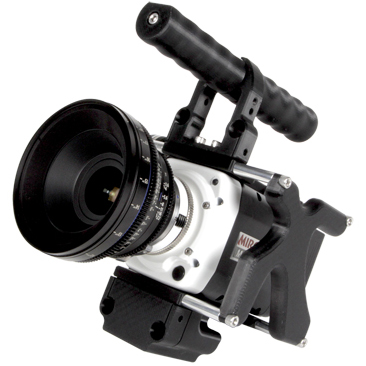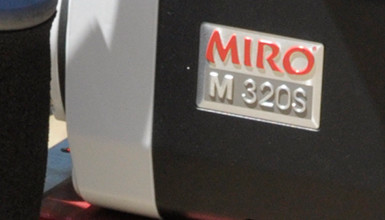Q: What is the Phantom Miro line from Vision Research?
A: At NAB 2012, Vision Research will launch the Miro M-series -- the most accessible Phantom cameras ever. With an extremely compact, lightweight body and an affordable price-point, the Miro M-series offers an entry into professional high-speed digital imaging and is ideal for handheld work. The flagship of the line is the Miro M320S.
 Q: What are the key specifications of the Miro M320S?
Q: What are the key specifications of the Miro M320S?
A: The Miro M320S has a sensor size near that of 35mm film and can record 1920x1080 up to 1,500 fps with an ISO of 1,100. Its maximum RAM size is 12GB. Data is transferred from RAM to an onboard CineFlash drive. An HD-SDI output is also available on this model.
Q: What is the Miro's image quality like?
A:When shooting high frame rates, one of the critical issues is light sensitivity, because the exposures are so quick. The new Miro cameras are rated at 1100 ISO, which is very fast, very sensitive. This means the image is well exposed without the need for massive amounts of light. Combined with Miro's high resolution and advanced colorimetry, this makes for truly cinematic quality images when using the RAW files, as well as superb quality television when recording the HD-SDI signal.
Q: Are there other cameras in the new Miro M line?
A: Yes, the Miro M120 is a 1080p camera with a top speed of 800 fps and CineFlash recording. The Miro M110 can run up to 1,600 fps, but the resolution is limited to 720p. The Miro M310 is also 720p and runs up to 3600fps. These three cameras have NTSC or PAL video output only, whereas the Miro M320S has HD-SDI output.
Q: What are the differences between the Miro M320S and the Phantom Flex?
A: There are several differences between the Flex and the Miro. The first is resolution. The Miro captures 1920x1080, while the Flex can capture the entire chip resolution of 2560x1440, which can then be down-resed to 1920x1080 or 2K.
When shooting 1920x1080 on either camera the sensor image size is identical, resulting in the same field of view for a given focal length lens. At the higher available resolution of the Flex, the sensor size is slightly larger than the Super-35 film format.
HQ mode, which performs a continuous black balance, is only available on the Flex. The Flex also has higher RAM capacity. At 1,000 frames per second (1920x1080), the 32GB Flex will capture 9.5 seconds of real time. The 12GB Miro can capture 3.8 seconds of real time at 1,000 fps. Miro's maximum frame rate is 1500 fps, while Flex's 2500 fps -- both at 1920x1020.
The Flex offers significantly faster transfer time from RAM storage. The Flex is capable of recording directly to a CineMag, while the Miro cannot record directly to the CineFlash.
This is not to say that one camera is "better" than the other. The choice is a matter of your budget and application.
Q: What are the applications for the Miro M line?
A: With its compact size and affordability the Miro is ideal for a broad range of applications. It makes shooting high-speed feasible in any close-quarters situation, for example inside a car. Shooters can "fly" this camera on smaller jibs, and actually fly it in RC controlled helicopters. Underwater and splash housings become much more practical, making the Miro a good choice for filming nature documentaries and sports like surfing.
AbelCine has also developed a line of modular accessories for Miro, which allows it to fit into virtually any production environment. We've introduced a new concept for a handheld solution called X-Grip, giving you even more freedom when operating the camera.
Q: What are the other key camera and accessory specs?
A: Miro records to CineFlash storage drives. A 60GB CineFlash and CineFlash Dock are included with purchase, and higher capacity drives are available, if desired. Miro is available in Nikon-F, 1" C-, PL- and EOS mount versions.
The camera is powered by Sony BP-U batteries, and AbelCine has developed a Breakout Box power supply.
Q: What are the new CineFlash storage drives?
A: This new media comes at a much lower cost per GB than the CineMags used by other Phantom cameras. It offers very fast read times, and the RAW cine files are widely compatible with most existing platforms and editing systems.

















